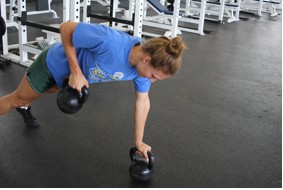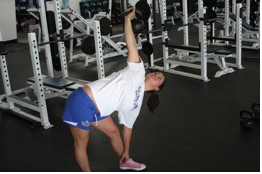With My Athletes...
Jeremy Layport, RKC Team Leader
November 23, 2009 09:33 AM
At the last San Jose RKC Pavel asked me to write on how I use Kettlebells with my athletes here at San Jose State. Some quick background information: the sports teams I directly oversee and work with at San Jose State are Baseball, Softball, Water Polo, Volleyball and Men's Golf. As you can see, all of these sports have an over-head throwing, hitting, swinging component to them. Therefore this means dealing with the nightmare that is the shoulder girdle and the overuse injuries associated with it. So, with that in mind, the first and foremost kettlebell bang for the buck exercise for me and those teams is the kettlebell snatch. Like I tell the athletes it's basically a backwards throw. Throwing or spiking a ball in a forward and downward motion as hard as possible in excess of 100 plus repetitions a day can cause some serious shoulder issues. High repetition snatching is the best thing for strengthening the shoulders connective tissues and musculature of that arm that only practices that forward and downward motion. What we teach at San Jose State on lowering the bell is to lead with the pinky and rotate the hand as it crosses the midpoint so that the thumb ends up between the hips. This movement is basically a PNF pattern as it's rotational and crosses the mid-saggital line of the body. PNF patterns are used all the time in rehabilitation settings to strengthen and increase range of motion. Due to poor posture and the way they swim, several of the water polo players I work with all have upper cross syndrome, where the thoracic spine is rounded excessively and the scapula is protracted putting the shoulder in sever risk of injury. The kettlebell snatch helps retract the scapula, stabilize, and strengthen the shoulder. The explosive hip extension every strength coach desires from the swing is magnified during the snatch (as it travels over head) and it really forces the athletes to "bring it" with the hips. On a side note, I really like Mike Boyle because he's always challenging and reinventing himself like any perfectionist should. In an article on T-Mag (Lifts I Never Did, Used to Do or Just Started Doing Again) Mike stated that he loved swings, but disliked snatches (Due to bruising). Well Mr. Boyle, if you take the Russian Kettlebell Challenge you will change your mind once again. If you teach the exercise right, your athletes will not have any burses from snatches or cleans for that matter. My only complaint about the kettlebell snatch if there was one, would be the tearing the hands up, which high repetitions will do.
Suitcase style one leg deadlift is another lift that will somehow always find a way into the above team's repertoire. This is basically due to the fact that about 80% of the "Division I Athletes" that come in to the program are "functionally" a huge mess. Let me tell you folks that "Gluteal Amnesia" is a real thing; I deal with it every day on some aspect or another. Literally, they don't make them like they used to, and it seems like collegiate strength coaches and sports medicine staffs end up trying to piece things back together. Most high school coaches and or club sports programs aren't aware enough of what is going on with athlete's bodies and how they move. During athlete's pre-high school years, it's all skill work with little to no general physical preparation. When they get to high school, most don't have educated enough coaches to understand not to strengthen bad motor programs or most don't even know what they're doing period. Suitcase style one legged deadlift stabilizes the knee, lower lumbar, hip while moving through the hip joint and works anti-rotational musculature of the mid-section. Great uni-lateral hip dominant leg work, that is either a sole "core lift" or more often than not a warm up exercise in my programs.
When reading your RKC manual, you will see the benefits of kettlebell swinging to be "accidental cardio." Well I have to say that at San Jose State, there is nothing accidental about the cardiovascular piece of kettlebell swings when it comes to our athletes. Our entire staff purposely plans for the swing sessions to be smoke sessions on some or most occasions. Chris Holder can be ruthless with what he makes the football team due at times. I have done some of them and it literally puts me down on the floor for about an hour or so afterwards. With my teams I am a little less as intensive with the volume per set and total volume of a swing set, but early on during our learning and basic "strength" phases, I love to have my teams swing between sets of exercises. If they are squatting and deadlifting, having them give 10-20 hard swings between sets is a great way to increase work capacity. Senior RKC Jeff O'Connor uses kettlebells between non-kettlebell movements to groove hip dominance in all movements. Most athletes I see are quad dominant movers, so getting them to swing between lifts gets them trained to load the hips during movements. Most of my teams are "In-season" during the spring. Springtime weather always seems to prevent me from running the teams at times, so swings are my only way of getting to them "cardiovascularly." A swing set I love is heavy swings for ten repetitions followed with twenty double snatches and then back to ten heavy swings. Heavy to fast seems to suck the air right out of people and the final heavy ten swings really breaks them off. Four to five sets of this and my athletes have had their conditioning for the day.
Kettlebells have become a mainstay at San Jose State. Although the athletes despise the workouts, they understand their value and place in their training regimen. I'm sure you are thinking, "this is it… I didn't learn a thing?" Well, I warned you from the start this was less an informative article and more a peek into my inner workings for how kettlebells have found their place in the training of athletes at San Jose State. A great article to learn from is or will be from Senior RKC Jeff O'Connor on how he uses kettlebells to teach basic motor skills, coordination, and spatial awareness with his athletes. You can also read some of Chris Holder past articles about his uses of kettlebells at Cal Poly and here at San Jose State.
Jeremy Layport, MA, RKC Team Leader is the Assistant Strength Coach at San Jose State University. You can contact him by email at:
j_layport@hotmail.com or
jeremy.layport@sjsu.edu Juliet Moss was a 2009 2nd team All American (2x), 2009 All Academic MPSF, Voted Team MVP, and leading Scorer (80 scores, Record) for the 2009 SJSU season. Juliet also earned a spot to train with the Junior National team over seas.
Juliet Moss was a 2009 2nd team All American (2x), 2009 All Academic MPSF, Voted Team MVP, and leading Scorer (80 scores, Record) for the 2009 SJSU season. Juliet also earned a spot to train with the Junior National team over seas. Tanya Torres was a 2009 Honorable Mention All American, 2009 ALL Academic MPSF, Voted Utility MVP, Most Inspirational, and a Team Captain.
Tanya Torres was a 2009 Honorable Mention All American, 2009 ALL Academic MPSF, Voted Utility MVP, Most Inspirational, and a Team Captain. 
Back